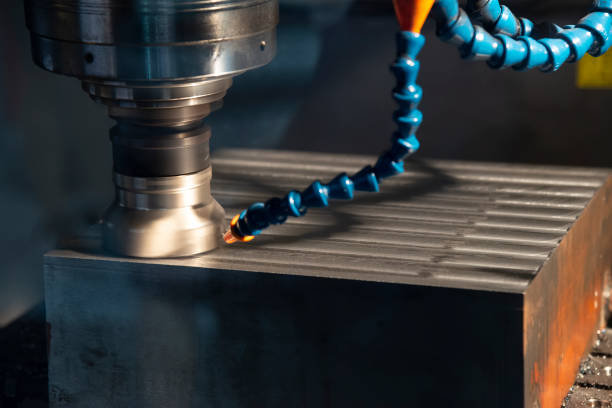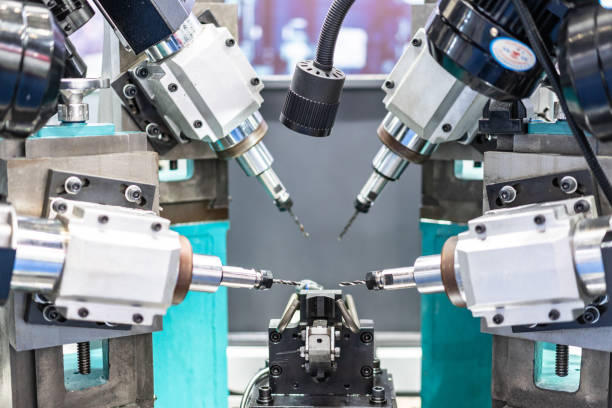What can a milling machine do? It can cut, drill, and mold materials. A milling machine brings cutting technology for different industries. Such machines are used on metals, plastics, and wood. By varying their functions, they offer endless opportunities.
A milling machine cuts materials like wood and metal. It uses rotating tools for various shapes. The table moves in X, Y, and Z axes. These axes help in precision.
The spindle holds cutting tools like end mills. With 0.001-inch accuracy, it performs detailed work. Each cut refines the material's surface. The machine creates complex parts efficiently.
Face milling produces flat surfaces on materials. It uses cutters with many teeth. The spindle rotates the cutter at high speeds. This rotation removes material quickly.
The table supports large workpieces. Operators adjust feed rates for quality. A smooth finish is achieved with carbide inserts. The process ensures accurate flatness. The machine maintains consistent results.

Plain milling involves horizontal cuts on surfaces. It uses plain milling cutters for tasks. The machine adjusts depth for precision. Workpieces stay steady on the table.
The cutter removes layers of material. The spindle speed impacts the finish. Operators control feed rates for efficiency. Results include smooth, even surfaces. The machine handles heavy-duty jobs.
Angular milling creates angled cuts on workpieces. It uses specialized cutters for angles. The machine tilts the workpiece or cutter. Angles range from 0° to 90°. This flexibility allows diverse cuts.
The spindle ensures steady rotation. Operators adjust angles for accuracy. The process produces precise bevels. The machine enhances angular design capabilities.
Vertical millers cut vertically. They use a spindle that moves up and down. These machines handle precise work. Operators adjust the spindle speed for various materials.
The table supports workpieces firmly. With a 0.001-inch tolerance, they make accurate cuts. Vertical millers craft detailed parts. They ensure smooth finishes.
Horizontal millers cut horizontally. They use an arbor to hold cutting tools. This design offers stability. These machines manage heavy materials. Operators control feed rates for quality.
Horizontal millers remove material efficiently. They create precise slots and grooves. The table moves for exact positioning. These millers produce robust parts.
Knee-type mills have an adjustable knee. The knee moves the table vertically. These mills offer flexibility. Operators change table height for depth control. The spindle handles various tools.
Knee-type mills ensure precision. They are used for detailed tasks. The design supports heavy workpieces. These mills achieve consistent accuracy.
Bed-type mills have a fixed table. The table does not move vertically. This design offers stability. Operators adjust the spindle for depth. Bed-type mills handle large workpieces.
They ensure precise cuts. The machine’s structure supports heavy-duty tasks. These mills are used in large-scale production. They deliver reliable performance.
Planer-style mills move the workpiece. The table travels under the cutter. This design allows large cuts. Operators control table speed for quality. Planer-style mills manage heavy materials.
They produce flat surfaces. The machine ensures precision with 0.01-inch accuracy. These mills handle extensive tasks. They create consistent, smooth results.
Milling machines cut metals like steel and aluminum. They handle hard materials efficiently. The spindle rotates cutting tools precisely. Operators adjust speeds for each metal type.
The machine can achieve 0.001-inch accuracy. Metals are shaped into complex parts. They handle high-strength tasks. The process ensures smooth and accurate finishes. Metal parts are durable.
Milling machines shape plastics like acrylic and PVC. They use specialized cutters. Operators set lower spindle speeds. The table holds plastic sheets securely. The machine makes precise cuts.
Plastics require careful handling to avoid melting. These materials are lightweight. Finished parts have smooth edges. Milling ensures detailed and accurate plastic components.

Milling machines cut composites like carbon fiber. These materials need specialized tools. Operators adjust feed rates for smooth cuts. The machine handles layered structures well.
Composites are strong and lightweight. Precision is crucial for aerospace parts. The spindle’s speed varies with the material. Milling produces high-quality finishes. Composite parts are reliable.
Milling machines create production items like gears and brackets. They use various cutting tools. Operators control the process for consistency. The machine ensures each item meets specifications.
Production runs require precision and speed. The table holds multiple workpieces. Finished items have exact dimensions. Milling supports mass production efficiently. The result is high-quality parts.
CNC milling machines offer unmatched accuracy. They use computer control for precision. Operators input exact measurements. The spindle moves with 0.001-inch precision.
This ensures detailed cuts. Machines maintain consistent results. Each part meets tight specifications. CNC accuracy enhances product quality. It boosts manufacturing efficiency and reliability.
Milling machines create precise parts like gears. They use end mills for accuracy. Operators adjust feed rates. The spindle ensures exact cuts. Parts meet strict tolerances of 0.01 mm.
Precision is crucial for performance. Machines produce consistent results. Detailed parts improve overall assembly quality. They ensure reliable operation.
Milling machines achieve tight tolerances in manufacturing. They handle complex designs with ease. Operators adjust spindle speeds. Tolerances are within 0.001 inches. This precision reduces errors.
Machines produce high-quality components. Consistent tolerances ensure parts fit perfectly. This boosts overall product reliability. Tight tolerances are essential for advanced manufacturing.
Milling machines ensure dimensional stability. They use rigid structures for support. Operators control cutting parameters. Stability is crucial for accurate parts.
The spindle maintains steady operation. Parts have consistent dimensions. This precision reduces waste. Dimensional stability enhances product reliability. It ensures high-quality, repeatable results.
CNC milling machines integrate computer control for precision. Operators program exact measurements. The machine executes cuts accurately. Spindle speeds adjust automatically. This integration ensures consistent quality. CNC systems enhance efficiency.
They manage complex designs with ease. Precise movements achieve tight tolerances. CNC milling boosts overall productivity. It provides reliable results.
Advanced milling machines feature automated tools. Tool changers swap cutters quickly. The spindle selects the right tool. Automation reduces setup time. It enhances efficiency. Machines handle various tasks seamlessly. Automated systems ensure precise tool placement.
The process minimizes human error. These tools improve production speed. They maintain consistent quality.
Milling machines have automatic tool-changing systems. The spindle switches tools rapidly. Operators program tool sequences. This feature increases efficiency. Tool changers hold multiple cutters. Machines perform various cuts without manual intervention.
They reduce downtime. Automated tool changes ensure precision. Consistent tool usage improves product quality. Tool-changing systems enhance overall productivity.

Milling machines use programmable logic controllers (PLCs). PLCs automate machining processes. Operators set specific parameters. The machine follows programmed instructions.
This ensures repeatable accuracy. PLCs manage complex tasks efficiently. They control spindle speeds and feed rates. Programmable logic enhances consistency. Machines achieve precise cuts every time. PLC integration boosts manufacturing reliability.
A milling machine can cut, drill, and shape materials. It handles metal, plastic, and wood effortlessly. With a spindle speed of 3600 RPM, precision work is guaranteed.
Each movement is accurate, even on tough surfaces. You can make slots, holes, and pockets. Changing tool bits allows different tasks. The machine’s bed size accommodates large pieces.
Milling machines create intricate parts with ease. They carve complex shapes from metal or plastic. High-speed spindles ensure smooth finishes. CNC models use G-code for precise control.
The machine adjusts to detailed designs seamlessly. It crafts gears, molds, and prototypes. Each pass refines the material further. Exact tolerances are maintained throughout the process.
Milling machines handle high production volumes efficiently. They maintain quality even in mass production. Automated feeds speed up the process. Each part is consistent with the next.
The machine operates continuously with minimal downtime. Tool changes are quick and easy. You achieve high output without sacrificing precision. Batch production runs smoothly and reliably.
Milling machines are essential in various industries. Aerospace relies on them for precision parts. Automotive uses them for engine components. The electronics industry requires fine milling for circuits.
Each sector demands accuracy and durability. Machines meet these needs with high performance. Advanced models do offer specialized capabilities. They adapt to evolving industrial requirements seamlessly.
Choosing the right milling machine depends on project needs. Desktop models suit small, detailed work. Industrial machines handle large-scale projects. Consider spindle power and speed for different materials. CNC models offer programmable precision.
Manual mills provide hands-on control. Look at bed size for accommodating various materials. Each model serves specific tasks effectively.
Milling machines require precise setup for optimal function. Aligning the machine ensures accuracy. Tool calibration is crucial for exact cuts. Each axis must be properly adjusted. Machines need stable power supply, often 220V. Proper ventilation prevents overheating.
Safety guards protect operators. Machines must be bolted down securely. Regular maintenance ensures consistent performance.
Integrating milling machines into production lines boosts efficiency. They connect seamlessly with conveyors. Automated tool changers reduce downtime. Machines communicate with central control units. Each part moves precisely through the system.
Sensors ensure accurate positioning. Conveyor speed matches machine output. This synchronization enhances productivity. Efficient integration reduces human error.
Optimizing workflow with milling machines improves productivity. CAD software designs feed directly into machines. Automation handles repetitive tasks. Each cycle maximizes material usage.
Machines run continuously with minimal supervision. Efficient layouts reduce movement time. Proper sequencing enhances output quality. Regular monitoring identifies issues early. Optimized workflows cut production costs.
Systematic coordination ensures milling machines perform efficiently. PLCs control machine operations. Each component synchronizes perfectly. Timely tool changes maintain accuracy. Machines adjust to varying workloads. Monitoring systems track performance metrics.
Operators receive real-time alerts. Consistent maintenance schedules prevent breakdowns. Coordinated systems deliver high-quality results. This integration streamlines the entire production process.
So, what can a milling machine do then? It generates accurate parts, deals with different materials and performs multifarious tasks. Get the most of milling machine and increase your productivity. For more info, visit CNCYANGSEN. Explore its capabilities today.